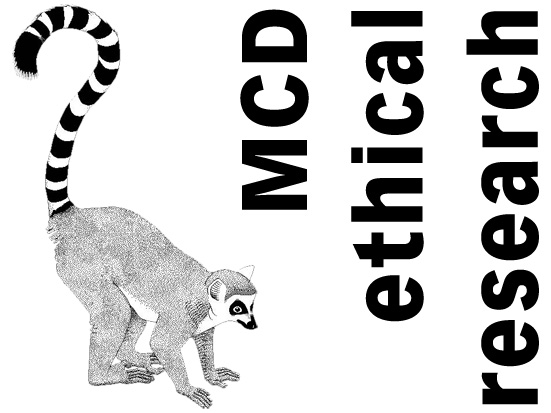A proposal for ethical research conduct in Madagascar
Abstract
Ethical conducts are gaining importance in times of increased globalization and research efforts. This paper presents a code of ethical conduct for researchers who plan to publish their studies with the journal Madagascar Conservation & Development. This paper will be subject to continuous adaptations and discussions.
Résumé
Les conduites éthiques gagnent en importance en ces temps marqués par une mondialisation croissante et une augmentation du volume des travaux de recherche. Cette contribution présente un code de conduite éthique destiné aux chercheurs qui envisagent de publier leurs études dans le journal Madagascar Conservation & Development. Cet article fera l’objet de discussions et sera régulièrement adapté.
References
Anonymous 2012. Promoting research integrity: a new global effort. The Lancet 380: 1445. (http://www.dx.doi.org/10.1016/S0140-6736(12)61822-4)
BASF (British Association of Social Workers). 2012. The Code of Ethics for Social Work. Statement of Principles. Available at https://www.basw.co.uk/codeofethics/
Biller-Andorno, N., Grimm, H., Walker, R. L. 2015. Professionalism and ethics in animal research. Nature Biotechnology 33: 1027–1028. (http://www.dx.doi.org/10.1038/nbt.3363)
Blehert, D. S. 2012. Fungal disease and the developing story of bat white-nose syndrome. PLoS Pathogens 8, 7: e1002779. (http://www.dx.doi.org/10.1371/journal.ppat.1002779)
Britt, D. P. 1984. Ethics, ethical committees and animal experimentation. Nature 311: 503–506. (http://www.dx.doi.org/10.1038/311503a0)
BSA (British Sociological Association). 2002. Statement of Ethical Practice for the British Sociological Association (March 2002). Available at http://www.britsoc.co.uk/the-bsa/equality/statement-of-ethical-practice.aspx
Directive 2010/63/EU of the European Parliament and of the Council of 22 September 2010 on the protection of animals used for scientific purposes. Legislation for the protection of animals used for scientific purposes. Official Journal of the European Union 20.10.2010: L 276/33–276/79. Available at http://ec.europa.eu/environment/chemicals/lab_animals/legislation_en.htm
Efferth, T., Banerjee, M., Paul, N.W., Abdelfatah, S., Arend, J. et al. 2016. Biopiracy of natural products and good bioprospecting practice. Phytomedicine 23, 2: 166–173. (http://www.dx.doi.org/10.1016/j.phymed.2015.12.006)
Garfield, E. 1996. What is the primordial reference for the phrase ‘Publish or Perish’. The Scientist 10, 12: 11. Available at http://www.the-scientist.com/?articles.view/articleNo/17944/title/What-Is-The-Primordial-Reference-For-The-Phrase--Publish-Or-Perish--/
Gluckman, P. 2014. The changing nature of science; can scientist rise to the challenge? Transcript of a speech to the Prime Minister of New Zealand, available at http://www.icsu.org/general-assembly/31st-general-assembly-auckland-2014/news/the-changing-nature-of-science-can-scientists-rise-to-the-challenge
Hammett, D., Twyman, C. and Graham, M. 2015. Research and Fieldwork in Development. Routledge, London.
Ito, R., Rakotondraparany, F. and Sato, H. 2013. Non-flying mammalian fauna of Ampijoroa, Ankarafantsika National Park. Madagascar Conservation & Development 8, 1: 45–48. (http://www.dx.doi.org/10.4314/mcd.v8i1.7)
Kolby, J. E., Smith, K. M., Ramirez, S. D., Rabemananjara, F., Pessier, A. P., et al. 2015. Rapid response to evaluate the presence of amphibian chytrid fungus (Batrachochytrium dendrobatidis) and ranavirus in wild amphibian populations in Madagascar. PLoS ONE 10, 6: e0125330. (http://www.dx.doi.org/10.1371/journal.pone.0125330)
Kombe, F., Anunobi, E.N., Tshifugula, N.P., Wassenaar, D., Njadingwe, D., et al. 2014. Promoting research integrity in Africa: An African voice of concern on research misconduct and the way forward. Developing World Bioethics 14, 3: 158–166. (http://www.dx.doi.org/10.1111/dewb.12024)
Mayer, T. 2015. Research integrity: the bedrock of the geosciences. In: Geoethics. Ethical Challenges and Case Studies in Earth Sciences. M. Wiss and S. Peppoloni (eds.), pp 71–81. Elsevier, Amsterdam. (http://www.dx.doi.org/10.1016/B978-0-12-799935-7.00007-1)
Phillott, A. D., Speare, R., Hines, H. B., Skerratt, L. F., Meyer, E., et al. 2010. Minimising exposure of amphibians to pathogens during field studies. Diseases in Aquatic Organisms 92, 2–3: 175–185. (http://www.dx.doi.org/10.3354/dao02162)
Resnik, D. B. and Shamoo, A. E. 2011. The Singapore Statement on Research Integrity. Accountability in Research: Policies and Quality Assurance 18, 2: 71–75. (http://www.dx.doi.org/10.1080/08989621.2011.557296)
Royal Society of London 2011. Knowledge, Networks and Nations. Global Scientific Collaboration in the 21st Century. The Royal Society, London. Available at https://royalsociety.org/topics-policy/projects/knowledge-networks-nations/report/
Sherwin, C. M., Christiansen, S .B., Duncan, I. J. H., Erhard, H. W., Lay, D. C., et al. 2003. Guidelines for the ethical use of animals in applied animal behaviour research. Applied Animal Behaviour Science 81, 3: 291–305. (http://www.dx.doi.org/10.1016/S0168-1591(02)00288-5)
Shuster, E. 1997. Fifty years later: the significance of the Nuremberg Code. New England Journal of Medicine 337, 20: 1436–1440. (http://www.dx.doi.org/10.1056/NEJM199711133372006)
Sikes, R. S., Gannon, W. L. and the Animal Care and Use Committee of the American Society of Mammalogists. 2011. Guidelines of the American Society of Mammalogists for the use of wild mammals in research. Journal of Mammalogy 92, 1: 235–253. (http://www.dx.doi.org/10.1644/10-MAMM-F-355.1)
South African Council For Social Services Professions. A Professional Council Striving for social justice through the promotion and enhancement of development social welfare. Professional Conduct and Ethics. Available at http://www.sacssp.co.za/Professionals/Conduct
Stoeckli, B., Wiesmann, U. and Lys, J.-A. 2014. A Guide for Transboundary Research Partnerships (2nd edition): 11 Principles and 7 Questions. , Bern, Switzerland. Swiss Commission for Research Partnerships with Developing Countries (KFPE). Available at http://www.naturalsciences.ch/uuid/564b67b9-c39d-5184-9a94-e0b129244761?force_download
St. John, F. A. V., Brockington, D., Bunnefeld, N., Duffy, R., Homewood, K., Jones, J. P. G., Keane, A. M., Milner-Gulland, E. J, Nuno, A. and Razafimanahaka, J. H. 2016. Research ethics: assuring anonymity at the individual level may not be sufficient to protect research participants from harm. Biological Conservation 196: 208–209. (http://www.dx.doi.org/10.1016/j.biocon.2016.01.025)
Thalmann, U. and Geissmann, T. 2005. New species of woolly lemur Avahi (Primates: Lemuriformes) in Bemaraha (Central Western Madagascar). American Journal of Primatology 67, 3: 371–376. (http://www.dx.doi.org/10.1002/ajp.20191)
Waeber, P. O., Wilmé, L., Mercier, J.-R., Camara, C. and Lowry II, P. P. 2016. How effective have thirty years of internationally driven conservation and development efforts been in Madagascar? PLoS ONE. (http://www.dx.doi.org/10.1371/journal.pone.0161115)
Wager, E. and Kleiner, S. 2011. Responsible research publication: international standards for authors. A position statement developed at the 2nd World Conference on Research Integrity, Singapore, July 22–24, 2010. In: Promoting Research Integrity in a Global Environment. T. Mayer and N. Steneck (eds.), pp 309–316. Imperial College Press / World Scientific Publishing, Singapore. Available at publicationethics.org/files/International%20standards_authors_for%20website_11_Nov_2011.pdf
Wilmé, L., Ravokatra, M., Dolch, R., Schuurman, D., Mathieu, E., Schuetz, H. and Waeber, P. O. 2012. Toponyms for centers of endemism in Madagascar. Madagascar Conservation & Development 7, 1: 30–40. (http://www.dx.doi.org/10.4314/mcd.v7i1.6)

Downloads
Published
Issue
Section
License
All journal content, except where otherwise noted, is licensed under a creative common Attribution 4.0 International and is published here by the Indian Ocean e-Ink under license from the author(s).


